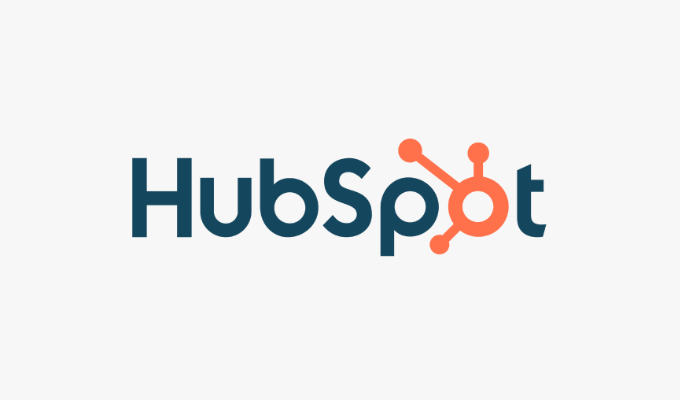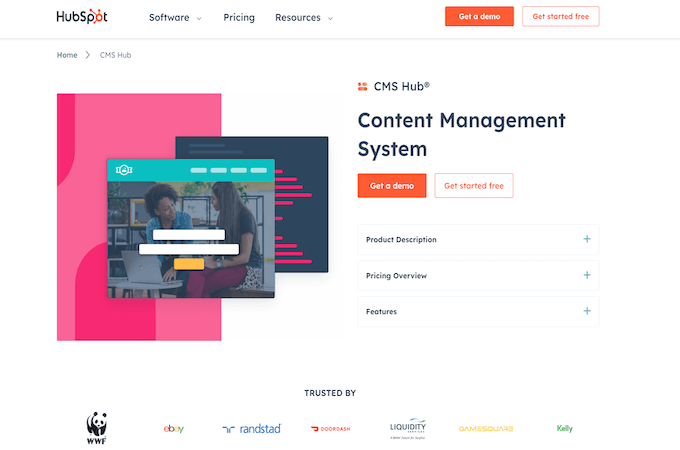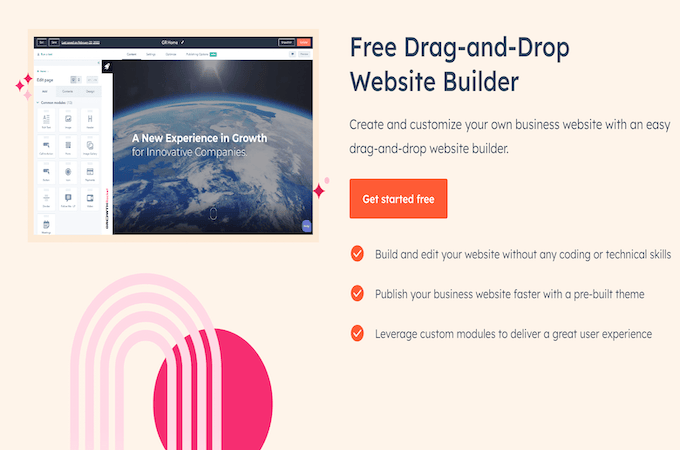HubSpot CMS (now part of HubSpot’s Content Hub) is a marketing-first content management platform that’s an excellent fit for marketers and creative teams at any skill level. It combines secure, managed hosting with an intuitive editor, built-in SEO tools, and tight CRM integration so you can build conversion-optimized websites without needing a developer.
If you want to launch fast and scale content over time, HubSpot’s CMS Hub/Content Hub offers free and paid tiers that support solo creators, startups, and growing companies alike. Below, we break down whether HubSpot CMS is right for you in 2025 and how it stacks up for modern content and search best practices.

HubSpot CMS Pros and Cons
Pros
- Very easy to use for non-technical teams
- Drag-and-drop page builder with live WYSIWYG previews
- Deep, native integration with HubSpot’s Smart CRM for personalization and lead capture
- Built-in SEO recommendations, A/B testing on higher tiers, and robust analytics
- AI features (e.g., Brand Voice, Content Remix, AI Blog Writer, and Breeze AI Agents) accelerate content production
- Free plan to get started; Starter removes HubSpot branding and adds more pages
- Hundreds of professionally designed themes and modular components
- Secure, fully managed cloud hosting with SSL/CDN included
- Large app marketplace with well over a thousand integrations
- Helpful onboarding resources and responsive support
Cons
- Free and Starter tiers include feature and page-count limits
- Seat-based pricing can jump noticeably as teams add users or need Pro/Enterprise features
- Theme system can feel rigid; deep visual customization isn’t as flexible as code-first builders
- Ecommerce relies on integrations or HubSpot’s Commerce Hub—improving, but still not as comprehensive as specialized storefront platforms
About HubSpot
HubSpot is best known for its CRM and marketing automation, but its platform also encompasses sales, customer service, operations, commerce, and content management. From marketing automation and contact management to live chat and ticketing, HubSpot centralizes customer data and execution. The CMS (now within Content Hub) adds managed hosting, themes, drag-and-drop editing, memberships, and fully native CRM personalization—making it easier to create connected experiences across your website and campaigns.
Nearly 268,000 organizations in 135+ countries use HubSpot. Alongside the software, HubSpot Academy offers free courses and certifications in SEO, inbound, operations, CMS development, social media, and more—useful for upskilling teams and standardizing best practices.
HubSpot Health and Stability
Founded in 2005, HubSpot popularized modern “inbound marketing” and went public in 2014. Today it’s a mature, fast-growing public company with thousands of employees worldwide and multi-billion-dollar annual revenue. In plain terms: HubSpot continues to invest heavily in its platform and AI roadmap, and it remains a stable, reputable choice for businesses that want their website and CRM under one roof.
If you build on HubSpot CMS/Content Hub, you benefit from an ecosystem that’s actively developed and supported. You shouldn’t need to worry about platform continuity or security—updates, hosting, and core maintenance are handled for you.
HubSpot CMS Pricing
HubSpot offers free and paid tiers so you can start quickly and upgrade as you scale. Pricing follows a seat-based model on Starter and includes bundled seats on higher tiers. Month-to-month and annual billing are available, with occasional introductory discounts for new customers.
HubSpot CMS Pricing Structure
You can use HubSpot CMS as a standalone product (within Content Hub) or bundled with other Hubs in a broader customer platform. Many teams choose the bundle to unify marketing, sales, service, and content on one CRM.
As of 2025, typical CMS/Content Hub tiers are:
Free — Launch with managed hosting, the website builder, basic SEO recommendations, and HubSpot branding.
Starter — Seat-based pricing (currently listed around $9 per seat). Removes HubSpot branding, raises page limits, adds personalization tokens, and includes live chat/email support.
Professional — Starts around $450/month and includes multiple seats. Adds advanced features like Content Remix, Brand Voice, podcasting, memberships/gated content, and deeper reporting.
Enterprise — Starts around $1,500/month and includes additional seats. Adds multisite management, advanced permissions/approvals, custom objects, serverless functions, and enterprise-grade governance.
You can also bundle CMS with other Hubs (marketing, sales, service, operations, commerce) in a single subscription. Bundle pricing varies by the number of paid users and (for marketing) your contact tiers. This route usually offers the best long-term value if multiple teams will work in HubSpot daily.
HubSpot CMS Trials and Guarantees
There’s no time-boxed trial because the Free tier lets you use core tools indefinitely—no credit card required. Free includes HubSpot branding and tighter limits; upgrading removes branding and expands capacity and features. You can also request a tailored demo to see enterprise features before committing.
HubSpot CMS Overview
HubSpot CMS gives marketers everything needed to publish, personalize, and optimize content that aligns with your revenue goals. Below are the highlights that matter most in 2025.
Content Management System
HubSpot’s CMS (within the Content Hub) is designed to deliver personalized, CRM-aware web experiences. Because content, contacts, forms, emails, and analytics live in one system, you can tailor pages and CTAs to lifecycle stage, industry, or past behavior without duct-taping tools together.
Hosting is fully managed with SSL and a global CDN. Connect your custom domain, publish quickly, and monitor performance from built-in reporting. Security and maintenance are handled by HubSpot, so your team can stay focused on content and conversion.

What sets HubSpot apart is its marketing-centric approach and growing AI layer. Tools like Brand Voice, Content Remix, case-study generation, AI blog writing, and Breeze AI Agents help teams publish faster in a consistent tone. CRM data powers smart content, while built-in SEO recommendations and analytics help you prioritize updates that move the needle.
Additional capabilities include embedded video and podcast hosting, memberships and gated content, payment tools, and seamless handoffs to marketing automation and sales. Non-technical teams can own day-to-day updates, while developers still have access to custom modules, serverless functions (Enterprise), and a full theme system.
Migration help is available if you’re moving from another CMS. HubSpot also works well for microsites—think online courses, events, and campaign-specific destinations—where speed to launch and built-in lead capture are critical.
A potential downside is ecosystem size compared with WordPress. While HubSpot’s marketplace is large and growing, WordPress still offers a broader universe of plugins. If you need highly specialized or niche extensions, expect to rely on HubSpot’s marketplace apps or custom development.
For teams that want a tightly integrated CRM + CMS with sales and service tools, HubSpot is a top contender. Starter is seat-based and affordable for small teams, while Professional and Enterprise unlock the automation, governance, and scale larger orgs need.
Free Website Builder
HubSpot includes a drag-and-drop website builder that makes it simple to produce pages without code. Start from professionally designed themes, then tweak layouts, typography, and modules to fit your brand. You can connect a custom domain, preview changes in real time, and publish with confidence.
The WYSIWYG editor shows exactly what visitors will see. Preview device variations, test messaging, and ship updates quickly—even if it’s your first site. Managed hosting, security, and monitoring are included.

Use pre-built modules for navigation, hero sections, forms, CTAs, galleries, and more. Most small sites can launch in hours, not weeks. Do keep in mind that advanced design control can feel more constrained than fully custom, code-first stacks.
HubSpot’s site builder is optimized for growth: built-in forms, chat, analytics, and CRM nurturing make it easy to capture leads and measure ROI from day one.
Get started free and build your first pages today.
Free Blog Maker
HubSpot’s free blog maker ships with SEO recommendations, a visual editor, themes, and CRM-ready lead capture. Whether you’re launching a content-heavy publication or adding a blog to an existing site, you can be up and running in minutes.
Design your blog to match your brand, draft posts in a clean editor, and preview before publishing. The platform handles hosting, monitoring, and security, and it integrates with your contacts, forms, and email for effortless nurturing.

The all-in-one approach is the standout: on-page SEO guidance, CTAs, forms, and reporting are built in. That means less tool sprawl, fewer plugins to maintain, and fewer integration headaches as traffic grows.
Free blogs include HubSpot branding and tighter limits; most teams upgrade to remove branding and lift caps on pages and features. The jump to Starter is straightforward and unlocks long-term scalability.
Branding Tools
HubSpot’s free branding utilities—including the Brand Kit Generator—make it easy to craft a consistent identity. Generate color palettes, logos, icons, and favicons, then reuse those assets across your site, email, and social channels.
These tools are great when you’re building (or rebuilding) the look and feel of your brand. Iterate quickly until you land on a system that works, then apply it across themes and templates for a cohesive experience.

Other branding tools from HubSpot worth exploring include:
- HubSpot Icon Maker
- HubSpot Favicon Generator
- HubSpot Color Palette Generator
- HubSpot Free Logo Maker
These free tools reduce reliance on outside designers for foundational assets and help you maintain visual consistency across every touchpoint.
HubSpot CMS Reputation
Reviews from verified users consistently praise HubSpot CMS for ease of use, CRM integration, and marketing performance features. Many call out the benefit of unifying web experiences with email, automation, and reporting in one place. Users also note the increasing value of HubSpot’s AI for scaling content while staying on brand.
Common critiques focus on design flexibility (themes can feel restrictive versus fully custom stacks), the step-ups in pricing as needs grow, and limited native ecommerce. Even so, overall sentiment remains positive, especially for teams prioritizing lead generation and lifecycle personalization over pixel-perfect bespoke design.
Final Verdict
HubSpot CMS—now part of Content Hub—is a capable, scalable platform for marketing-driven websites. It pairs a friendly editor with CRM-level personalization, strong SEO tooling, and conversion features that help turn traffic into pipeline.
If you want fewer moving parts, faster iteration, and built-in analytics, HubSpot is easy to recommend. The Free tier is great for testing; Starter removes branding and raises limits; Professional and Enterprise unlock AI-assisted content ops, governance, and scale. Whether you’re building from scratch or consolidating tools, HubSpot CMS is a smart, future-proof choice. Get started for free today.
